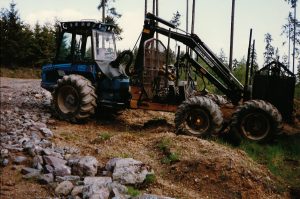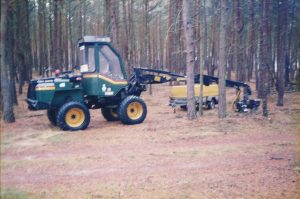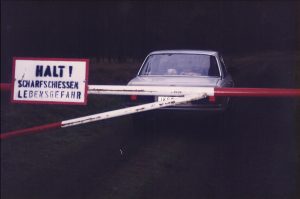In 1990, the forestry business in Sweden was slow. But early that year Germany suffered three or four heavy storms that resulted in millions of cubic meters of windthrow. By that time, our type of forest machines hadn’t had their breakthrough in Germany yet. Chainsaws, skidders, and even horses were still the main tools. They needed machines to get all the wind-thrown trees out of the woods quickly. That was lucky for us in Sweden and Finland. We came to the rescue.
Forest machine biography – the end of the line
I had never been to Germany and knew nothing about German forestry when I arrived there in the autumn of 1990. I soon found out that the difference was big even though Germany is less than a two-hour drive from Sweden (through Denmark) and has lots of forest land. However, where I went was eight hours further down in Germany where I worked for a German contractor operating a Rottne Rapid EGS, my first one-grip harvester. Today referred to as a “harvester”.
It was an old machine that had seen better days. It worked most of the time, but it was difficult to handle the thick spruce trees that had been wind thrown by at least three storms in different directions. The machine was meant to fall the trees, not pull them out of unorganized piles.
After a few months and newly discovered grey hairs (I was only 28 at the time), I got to operate a new Rottne Rapid forwarder instead. I wasn’t very experienced with forwarders, but that machine suited me better.
Even though the Rottne Rapid was more modern than the Blondin, it had many familiar details from the Blondin that I was used to. It was still a simple machine, especially the forwarder, where not much could break down. That was convenient as spare parts for those “rare” machines were hard to get in Germany at the time.
Study break
After almost a year in Germany, and a minor dispute with my employer, I decided to go back to Sweden. It was time to become “something”. With a lawyer as a sister to be compared with, a logger wasn’t good enough(???) … Anyway, I felt it was time to move on.
I managed to get accepted at forester school which in Sweden lies under the University of Agricultural Sciences, SLU. I was suddenly a student at a university which was something completely different from what I was used to. I almost quit after a month because I couldn’t stand all the theorists who (to me) didn’t seem to have seen a real forest.
However, I stayed and graduated which I didn’t regret. Even if I never worked as a forester after that, the study time opened many doors and of course, I also learned a thing or two.
Back behind the controls
In those days, a major inventory was going on in the Swedish forests. An “overview” inventory that needed thousands of foresters to do the job. During my years at the forester school, Sweden got a new government that closed that project meaning that thousands of foresters suddenly were unemployed. So, when I and my classmates applied for a forester job, we competed with hundreds of experienced foresters on each offered job.
I was one of few in my class that already had both a profession and an experience which was machine operating. So, I went back to that.
There was a lack of machine operators, so it didn’t take long. My Rottne experience soon gave me a job operating a Rottne Rapid two-grip harvester, this time the six-cylinder version called SMV. Apart from the engine, it was like the previous Rapids I had been operating.
Germany calling
If nothing else, the German adventure had been profitable. When I heard that operators still were needed and this time in northern Germany, closer to home, I took the chance and went down again. This time the owner of the machine was a Swedish contractor who had stayed in Germany after the storms in -91 and -93 and now was doing normal forestry.
The company had several machines. Among those, one that nobody wanted to operate because it was old and fragile – it broke down often. That was the machine that I got and that came to be one of my favorites, an ÖSA 0470 Lillebror harvester.
When I arrived, it was parked due to a breakdown. It was something with the fuel system that took me and the owner almost three days to find and repair. The company had a payment system where the salary was based on a percentage of the turnover of the machine you operated. New machines had a low percentage, as they were supposed to run without breakdowns. The Lillebror had a high percentage as it was known to break down a few times a week.
My reputation as a machine operator was something like; “slow but careful”. “My” machines seldom broke down which the owners liked. If you ask me because I treated them with respect. Consequently, the Lillebror didn’t break down in my hands. That fact, plus the nice pine forest that you see in the blurry photo above, meant MONEY! To this day I have never made so much money as with that machine. That’s why it is my favorite machine.
Don’t get me wrong, it did break down but not often. Lillebror and I became good friends while working at a military site in former DDR (East Germany). An active shooting site for artillery meaning the sites I worked in was chosen according to the caliber of the canons they used for the moment.
The owner on the other hand didn’t like that machine at all. He traded it for Norcar 400H harvester. For me, that was like hitting a wall at full speed. Both percentage, production, and salary went down to a level that I easily could make at home in Sweden. No point in living in a suitcase anymore.
Back home
And back to school. I completed my studies with one year of learning marketing. During that year I operated a new Rottne SMV Rapid two-grip harvester on Fridays and Saturdays to finance my studies. After graduation, I operated several machines waiting for another suitable job. I even went back to Germany and the Norcar harvester, but just for some months.
Yet another Rottne rapid harvester (not SMV this time), a Valmet 892 forwarder, a Valmet 838 forwarder, and a Woodpac (later Valmet) slash bundler were some of the machines I operated the years before I became a salesman for chippers in 1999. Since then, I have operated machines from time to time on weekends just to help friends that have had too much work to do. But basically, my machine’s operating days are over. The chainsaw and the computer are my machines nowadays. But it has been a nice journey so far.
Sources: Elmia Classics, and Solhem9.se
Photos: Per Jonsson
Previous articles about “my” machines:














